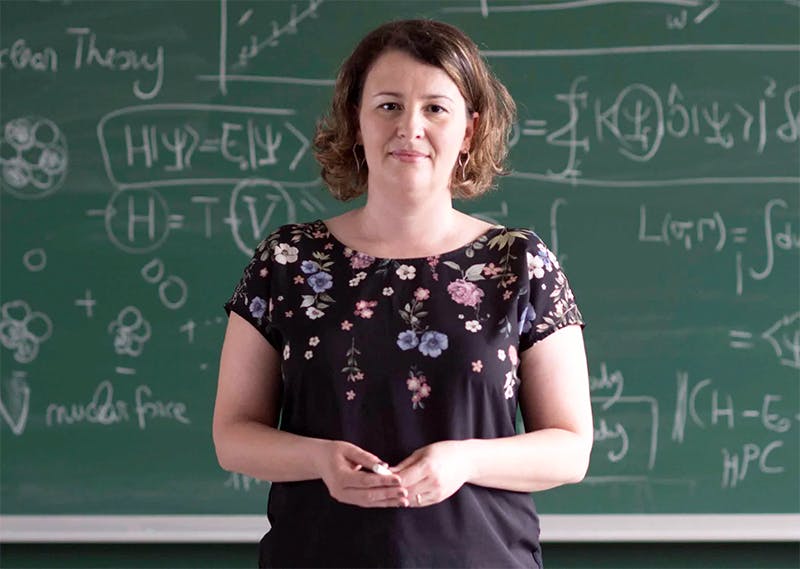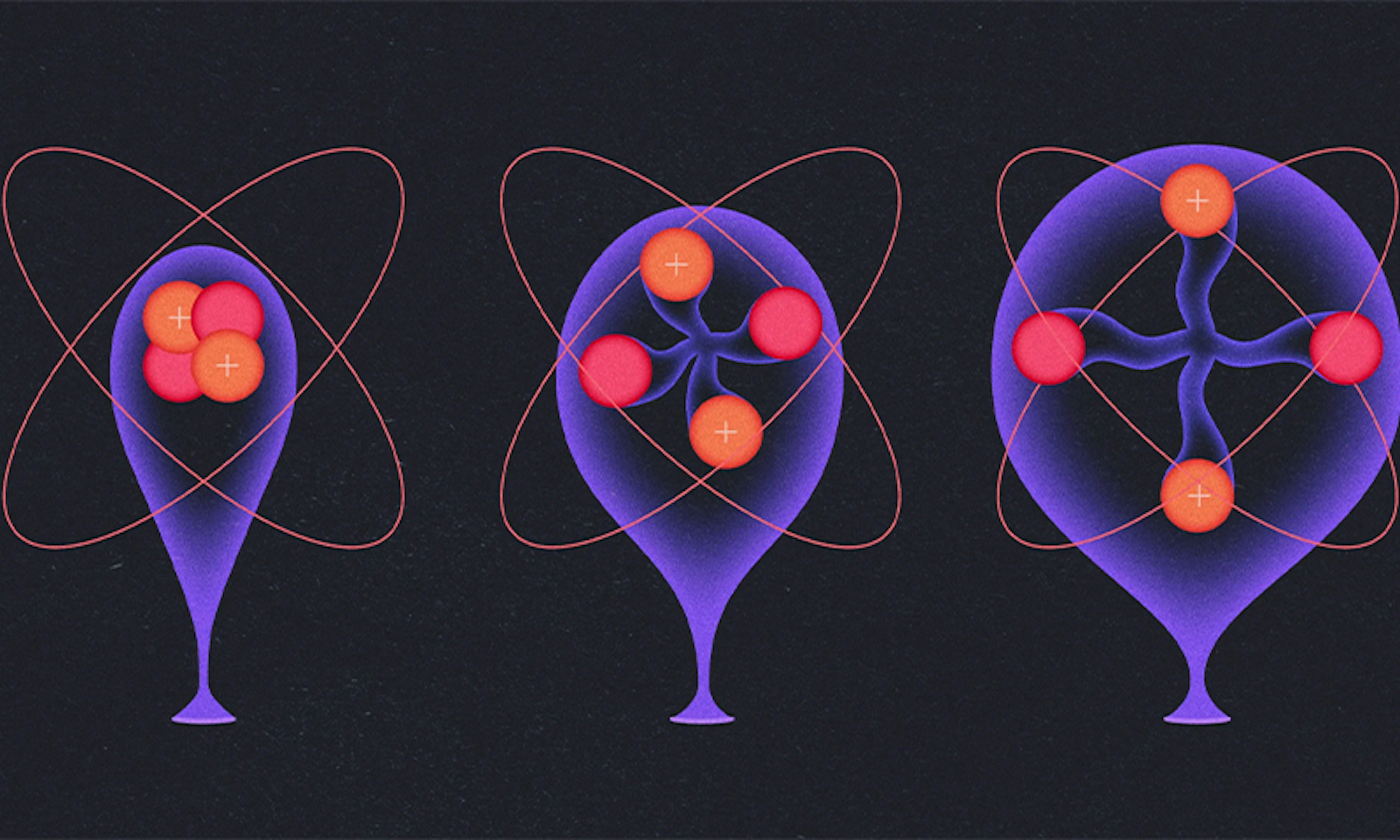A new measurement of the strong nuclear force, which binds protons and neutrons together, confirms previous hints of an uncomfortable truth: We still don’t have a solid theoretical grasp of even the simplest nuclear systems.
To test the strong nuclear force, physicists turned to the helium-4 nucleus, which has two protons and two neutrons. When helium nuclei are excited, they grow like an inflating balloon until one of the protons pops off. Surprisingly, in a recent experiment, helium nuclei didn’t swell according to plan: They ballooned more than expected before they burst. A measurement describing that expansion, called the form factor, is twice as large as theoretical predictions.
“The theory should work,” said Sonia Bacca, a theoretical physicist at the Johannes Gutenberg University of Mainz and an author of the paper describing the discrepancy, which was published in Physical Review Letters. “We’re puzzled.”
The swelling helium nucleus, researchers say, is a sort of mini-laboratory for testing nuclear theory because it’s like a microscope—it can magnify deficiencies in theoretical calculations. Physicists think certain peculiarities in that swelling make it supremely sensitive to even the faintest components of the nuclear force—factors so small that they’re usually ignored. How much the nucleus swells also corresponds to the squishiness of nuclear matter, a property that offers insights into the mysterious hearts of neutron stars. But before explaining the crush of matter in neutron stars, physicists must first figure out why their predictions are so far off.
Bira van Kolck, a nuclear theorist at the French National Center for Scientific Research, said Bacca and her colleagues have exposed a significant problem in nuclear physics. They’ve found, he said, an instance where our best understanding of nuclear interactions—a framework known as chiral effective field theory—has fallen short.
“This transition amplifies the problems [with the theory] that in other situations are not so relevant,” van Kolck said.
The Strong Nuclear Force
Atomic nucleons—protons and neutrons—are held together by the strong force. But the theory of the strong force was not developed to explain how nucleons stick together. Instead, it was first used to explain how protons and neutrons are made of elementary particles called quarks and gluons.
For many years, physicists didn’t understand how to use the strong force to understand the stickiness of protons and neutrons. One problem was the bizarre nature of the strong force—it grows stronger with increasing distance, rather than slowly dying off. This feature prevented them from using their usual calculation tricks. When particle physicists want to understand a particular system, they typically parcel out a force into more manageable approximate contributions, order those contributions from most important to least important, then simply ignore the less important contributions. With the strong force, they couldn’t do that.
Then in 1990, Steven Weinberg found a way to connect the world of quarks and gluons to sticky nuclei. The trick was to use an effective field theory—a theory that is only as detailed as it needs to be to describe nature at a particular size (or energy) scale. To describe the behavior of a nucleus, you don’t need to know about quarks and gluons. Instead, at these scales, a new effective force emerges—the strong nuclear force, transmitted between nucleons by the exchange of pions.
Weinberg’s work helped physicists understand how the strong nuclear force emerges from the strong force. It also made it possible for them to perform theoretical calculations based on the usual method of approximate contributions. The theory—chiral effective theory—is now widely considered the “best theory we have,” Bacca said, for calculating the forces that govern the behavior of nuclei.

In 2013, Bacca used this effective field theory to predict how much an excited helium nucleus would swell. But when she compared her calculation to experiments performed in the 1970s and 1980s, she found a substantial discrepancy. She’d predicted less swelling than the amounts measured, but the experimental error bars were too big for her to be sure.
Ballooning Nuclei
After that first hint of a problem, Bacca encouraged her colleagues at Mainz to repeat the decades-old experiments—they had sharper tools at their disposal and could make more precise measurements. Those discussions led to a new collaboration: Simon Kegel and his colleagues would update the experimental work, and Bacca and her colleagues would try to understand the same intriguing mismatch, if it emerged.
In their experiment, Kegel and his colleagues excited the nuclei by shooting a beam of electrons at a tank of cold helium gas. If an electron zipped within range of one of the helium nuclei, it donated some of its excess energy to the protons and neutrons, causing the nucleus to inflate. This inflated state was fleeting—the nucleus quickly lost grasp of one of its protons, decaying into a hydrogen nucleus with two neutrons, plus a free proton.
As with other nuclear transitions, only a specific amount of donated energy will allow the nucleus to swell. By varying the electrons’ momentum and observing how the helium responded, scientists could measure the expansion. The team then compared this change in a nucleus’ spread—the form factor—with a variety of theoretical calculations. None of the theories matched the data. But, strangely, the calculation that came closest used an oversimplified model of the nuclear force—not the chiral effective field theory.
“This was totally unexpected,” said Bacca.
Other researchers are equally mystified. “It’s a clean, well-done experiment. So I trust the data,” said Laura Elisa Marcucci, a physicist at the University of Pisa in Italy. But, she said, the experiment and theory contradict one another, so one of them must be wrong.
Bringing Balance to the Force
In hindsight, physicists had several reasons to suspect that this simple measurement would probe the limits of our understanding of nuclear forces.
First, this system is particularly persnickety. The energy needed to produce the transiently inflated helium nucleus—the state researchers want to study—lies just above the energy needed to expel a proton and just below that same threshold for a neutron. That makes everything hard to calculate.
The second reason has to do with Weinberg’s effective field theory. It worked because it allowed physicists to ignore the less important parts of the equations. Van Kolck contends that some of the parts deemed less important and routinely ignored are in fact very important. The microscope provided by this particular helium measurement, he said, is illuminating that basic error.
“I cannot be too critical because these calculations are very difficult,” he added. “They’re doing the best they can.”
Several groups, including van Kolck’s, plan to repeat Bacca’s calculations and find out what went wrong. It’s possible that simply including more terms in the approximation of the nuclear force might be the answer. On the other hand, it’s also possible that these ballooning helium nuclei have exposed a fatal flaw in our understanding of the nuclear force.
“We exposed the puzzle, but unfortunately we have not solved the puzzle,” Bacca said. “Not yet.”
This article was originally published on the Quanta Abstractions blog.
Lead image: Excited helium nuclei inflate like balloons, offering physicists a chance to study the strong nuclear force, which binds the nucleus’s protons and neutrons. Credit: Kristina Armitage/Quanta Magazine.




























